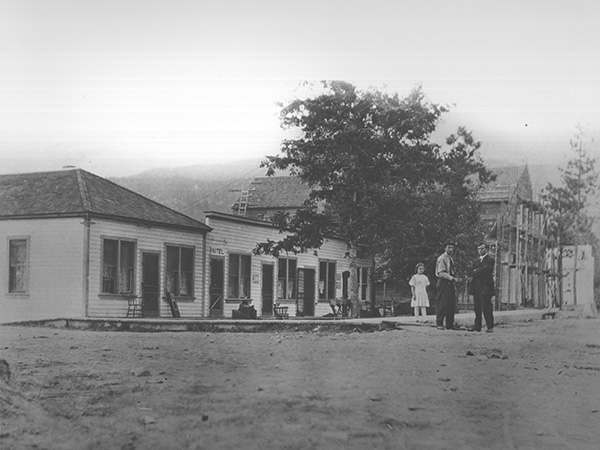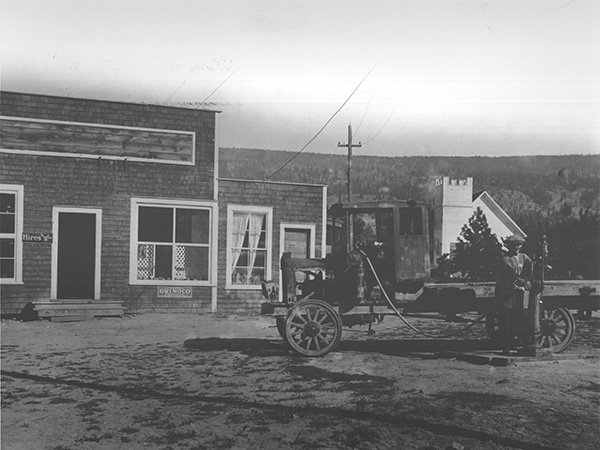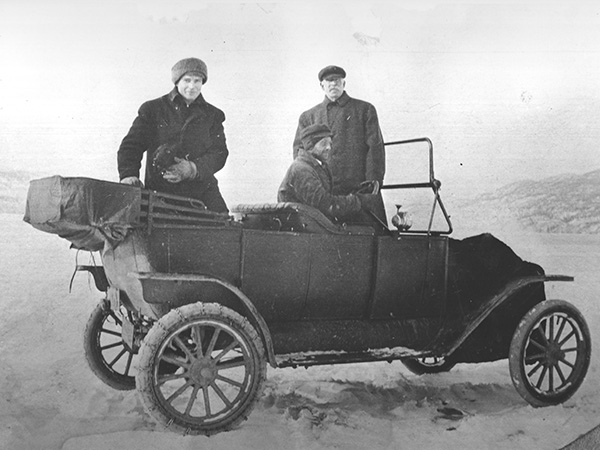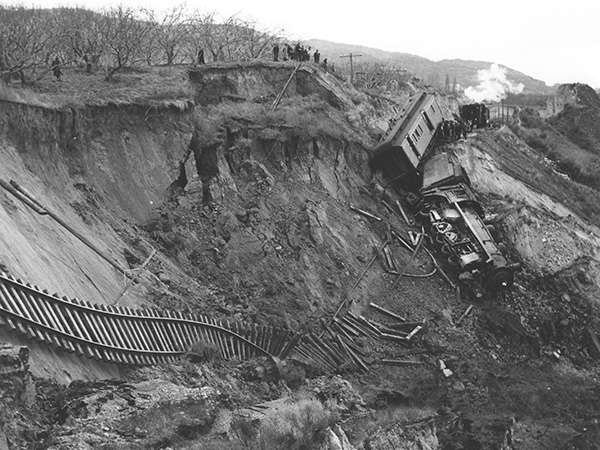The first claim to Nine Mile, which is what Naramata was originally called, was Tom Ellis a Penticton pioneer who had grazing rights to all the lands on the east side of Okanagan lake. After John Moore Robinson had developed Peachland and Summerland he turned his attention to the delta at Nine Mile Point where he acquired three thousand acres from Tom Ellis. In 1907 the Okanagan Trust Company under the watchful eye of J.M. Robinson had attractive brochures printed and sent to potential customers in eastern Canada, the United States and Britain. Response to his advertisement was favorable and Naramata began.
This photograph was taken from the deck on the maiden voyage of the CPR stream wheeler the SS Okanagan in 1907. From the left are the tent home of new arrivals, Scaife’s Boat Works, on the wharf is the laundry, directly behind that is the Lakeside Hotel, behind that the Wellband home, next is the Land Co Cottage and behind that is the school.
The sign to the extreme right says, “Naramata fruit lands for sale”. The CPR freight boat “York” is at the wharf. The crowd on the wharf are the prospective land buyers and the residents who took the occasion to welcome the new stern-wheeler on its initial voyage around Okanagan Lake.


This was early Naramata. Looking from left to right the large two-story building is the Naramata Store with the Opera House on the second story. Set back is the United Church; the Naramata Hotel is on the waterfront (in the same location today). Set back is Endacott’s barn and the Syndica House owned by the Rowe family. Farther over are the Scaife’s boathouse and then the sheds on the wharf. The small building this side of the wharf was Rowe’s Boat House where their boats were repaired in the wintertime. The home with the cottage roof is now the County Squire Restaurant.
In the foreground is the jail, apparently never used.
Here is another view of early Naramata showing the Naramata hotel, the Naramata Store, the Syndica House and some residential buildings. The Syndica House was owned by the Rowe Family who owned the three boats that provided transportation between Summerland, Penticton, and Naramata with the occasional trip to Kelowna.


This was First Street; the wharf is to the left and out into the lake of the photo. The Lakeside Hotel was next to the wharf. The Laundry was on the wharf. We were not too environmentally conscious those days! The large building is the J.M. Robinson’s first store, which he sold and then built across from his hotel. Farther up the street is Rowe’s Bottling Works.
This whole area is now covered by the Packing House complex.
This was the Naramata Store on First Avenue. Please note the lone gas pump next to the building. Next were the Post Office and the Naramata Library. The building far left was J.M. Robinson’s cottage.
The cart beside the store was used by Mr. Bartlett, the Post Master, to transport the bags of mail from the SS Sicamous when it tied up at the wharf each day. The signs are for Orinoco Tobacco, Hires root beer and Martin-Senour paint.


This was probably the whole population of Naramata who came out to clear the area for the present day school. The residents of the new village of Naramata were very community minded and intent on creating a community as ideal as they could imagine. The residents of Naramata came from as far as Michigan in the USA, many from Ontario and some from the Prairie Provinces.
This was the first Naramata School; it became a Community Hall in 1935.


The Naramata Livery, owned by Harold Endacott, was on Lily Street. The teamsters and their horses shown would represent most of the teams working in Naramata at that time. Horses were used to build roads, big basements, haul supplies and convert the sagebrush hills to orchard land.
One of the teamsters in the photo is Dave Goode, for whom Goode creek is named. Dave had come to Naramata from Sandon in the Kootenays where he had been a stagecoach driver. He had a small ranch near a creek north of Naramata, which now bears his name. Hs saddle is in the Naramata Museum.
This is Dick Elver gassing up his solid rubber tired Federal truck. It had a wooden cab, wooden spoke wheels and a carbide light seen on the front of the frame, the carbide tank is by the door. The truck had many uses, one of them being to move the railroad cars on the siding from the packinghouse to the wharf. Refrigerator cars called, “refers” were iced in Penticton, barged to Naramata, and then the fruit was loaded into the car, which was again loaded on a barge and taken to Okanagan Landing where the cars were eventually put on the main line of the CPR and taken to Vancouver or East.


Patterson’s Naramata-Penticton Stage also served as a delivery vehicle. The Stage was a reference to the early stagecoaches; early buses and autos were referred to as auto-stages. Later the Naramata Bus had celluloid curtains rather than roll down canvass, but still wooden benches.
Many of these vehicles, particularly school buses, had a removable cab so the truck could be used to haul fruit or at times, manure, which was the only fertilizer orchardist’s had. The cab was installed in time to be used as a school bus. The school kids could readily tell what the truck had been hauling that day.
When the lake froze over solid enough people crossed the ice to Summerland. Some braver folk road over in chain equipped autos such as this one. Mrs. Ruth Rounds recalled going across the ice to a dance in Summerland with a team of horses. One time a group returning from Summerland found the ice bending under the team. The passengers got out of the sleigh and stayed a safe distance from the team. All made it safely to shore. George Cook had an icehouse; used for refrigeration, and cut ice in front of Manitou Park to fill the sawdust lined building for ice n the summer time.
Usually if the lake freezes over it is too cold for the fruit trees.


This trestle at Four Mile, which is at the City of Penticton, limits, still perfectly good, it’s just covered by fill, as is the trestle at Three Mile, just above the Three Mile Restaurant. The wooden trestles, made of creosote timbers, were extremely susceptible to fire from cinders from the steam engine. The two barrels of water on either end of the trestle were used by the section crew who followed after the train and put out any sparks in the event that there was a fire.
The 2,2 percent grade out of Penticton was a tough climb for the engines, which took on necessary water at the tower at Arawana, a CPR maintenance section above Naramata.
This is a motorized speeder at the little tunnel above Naramata. One can see the tunnel on the mountainside above Naramata. The large three quarter of a mile tunnel farther along the tracks has been blocked because of unsafe conditions in the tunnel. Cars and bikes did go through the tunnel which was dark, curved, and dripped water.
The motorized “speeder” was used by the section gangs to check the tracks before and after a train went through. A velocipede was propelled by the riders pumping a handle to make the vehicle move.


This is referred to as the “little Joe Ramond wreck” which happened in November of 1949. Irrigation from the orchards above had softened the clay bank, which gave way and the train slid down toward the lake above the Yacht Club basin in Penticton. No one was injured or killed and the engine was pulled back up and a new track built around the slide. The cowcatcher from the locomotive was recently retrieved from the lake. An information kiosk has been erected at the site and the cow-catcher is on display there.

